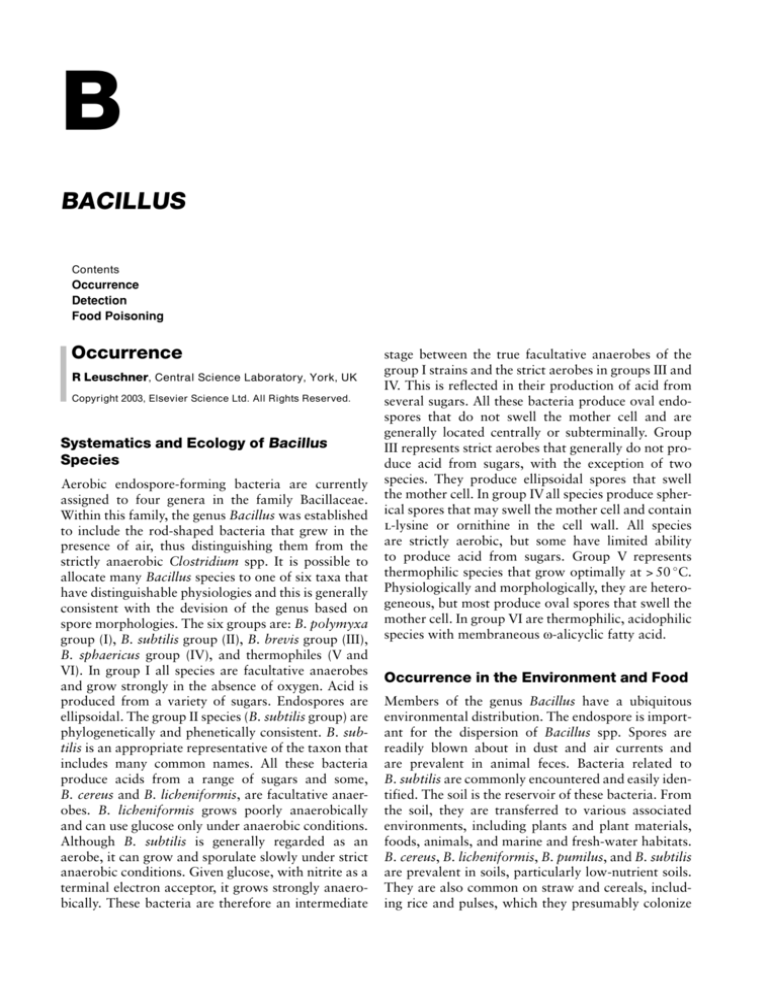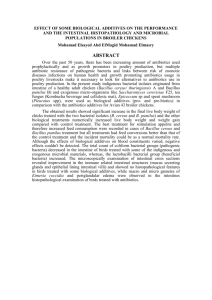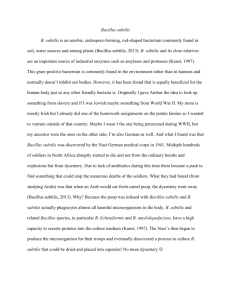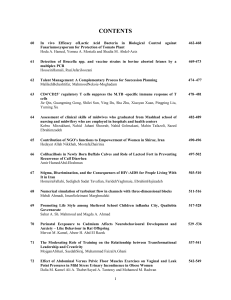
B
BACILLUS
Contents
Occurrence
Detection
Food Poisoning
Occurrence
R Leuschner, Central Science Laboratory, York, UK
Copyright 2003, Elsevier Science Ltd. All Rights Reserved.
Systematics and Ecology of Bacillus
Species
0001
Aerobic endospore-forming bacteria are currently
assigned to four genera in the family Bacillaceae.
Within this family, the genus Bacillus was established
to include the rod-shaped bacteria that grew in the
presence of air, thus distinguishing them from the
strictly anaerobic Clostridium spp. It is possible to
allocate many Bacillus species to one of six taxa that
have distinguishable physiologies and this is generally
consistent with the devision of the genus based on
spore morphologies. The six groups are: B. polymyxa
group (I), B. subtilis group (II), B. brevis group (III),
B. sphaericus group (IV), and thermophiles (V and
VI). In group I all species are facultative anaerobes
and grow strongly in the absence of oxygen. Acid is
produced from a variety of sugars. Endospores are
ellipsoidal. The group II species (B. subtilis group) are
phylogenetically and phenetically consistent. B. subtilis is an appropriate representative of the taxon that
includes many common names. All these bacteria
produce acids from a range of sugars and some,
B. cereus and B. licheniformis, are facultative anaerobes. B. licheniformis grows poorly anaerobically
and can use glucose only under anaerobic conditions.
Although B. subtilis is generally regarded as an
aerobe, it can grow and sporulate slowly under strict
anaerobic conditions. Given glucose, with nitrite as a
terminal electron acceptor, it grows strongly anaerobically. These bacteria are therefore an intermediate
stage between the true facultative anaerobes of the
group I strains and the strict aerobes in groups III and
IV. This is reflected in their production of acid from
several sugars. All these bacteria produce oval endospores that do not swell the mother cell and are
generally located centrally or subterminally. Group
III represents strict aerobes that generally do not produce acid from sugars, with the exception of two
species. They produce ellipsoidal spores that swell
the mother cell. In group IV all species produce spherical spores that may swell the mother cell and contain
l-lysine or ornithine in the cell wall. All species
are strictly aerobic, but some have limited ability
to produce acid from sugars. Group V represents
thermophilic species that grow optimally at > 50 C.
Physiologically and morphologically, they are heterogeneous, but most produce oval spores that swell the
mother cell. In group VI are thermophilic, acidophilic
species with membraneous o-alicyclic fatty acid.
Occurrence in the Environment and Food
Members of the genus Bacillus have a ubiquitous
environmental distribution. The endospore is important for the dispersion of Bacillus spp. Spores are
readily blown about in dust and air currents and
are prevalent in animal feces. Bacteria related to
B. subtilis are commonly encountered and easily identified. The soil is the reservoir of these bacteria. From
the soil, they are transferred to various associated
environments, including plants and plant materials,
foods, animals, and marine and fresh-water habitats.
B. cereus, B. licheniformis, B. pumilus, and B. subtilis
are prevalent in soils, particularly low-nutrient soils.
They are also common on straw and cereals, including rice and pulses, which they presumably colonize
0002
356 BACILLUS/Occurrence
0003
tbl0001
from wind-blown soil particles and dust. Endospores
of bacilli represent a metabolically inactive survival
form. They are characterized by high resistance
against heat, dryness, irradiation, and other unfavorable environmental conditions. The success of the
endospore for the survival of the species depends on
an effective mechanism to resuscitate and enter the
vegetative cell cycle to multiply. It is usually the case
that spores resuscitate under good environmental
conditions that allow germination and cell growth.
Food of various origin and compositions can offer
these conditions and this can lead to spoilage or
even food poisoning due to growth of bacilli in food.
Spores and vegetative cells of Bacillus cereus and
other food-poisoning Bacillus spp. occur widely in
soils (105–106 CFU g1) and may be found in raw
materials and processed foods which were not sterilized by heat or irradiation. They constitute a major
portion of the microbial flora of raw milk and easily
contaminate various dairy products, causing spoilage
with their proteolytic, lipolytic, and saccharolytic activities. B. cereus was detected and enumerated in
milk, vegetable, and meat-based products (Table 1).
B. cereus is a problem to the dairy industry because it
contaminates the udders of cows while they graze in
the fields and can be introduced into milk. B. licheniformis, B. pumilus and B. subtilis were the most
Table 1 Prevalence of Bacillus cereus in raw and processed
food products
Food product
Rice and oriental foods
Raw rice
Boiled rice
Fried rice
Egyptian rice dishes
Japanese noodles
Soybean curd (tofu)
Sashimi (raw fish)
Milk and dairy products
Raw milk
Pasteurized milk
Milk powder
Icecream
Spices
Meat and meat products
Raw meats
No. of
samples
examined
No. positive
for B. cereus
(%)
B. cereus
counts g1
or ml1
13
32
14
252
14
204
172
200
257
467
228
46
38
93
10
86
24
40
8
56
31
14
102–103
103–107
101–103
102–105
101–103
102–105
101–104
101–104
101–104
101–106
102–103
100
100
120
100
110
9
35
27
48
53
101–102
101–103
101–103
101–103
101–104
133
452
2
6
101–102
101–102
Modified from Kramer JM and Gilbert RJ (1989) Bacillus cereus and other
Bacillus species. In: Doyle MP (ed.) Foodborne Bacterial Pathogens, pp. 21–
70. New York: Marcel Dekker.
commonly isolated Bacillus species in bakeries and
milk (Tables 2 and 3). The incidence of B. cereus and
B. subtilis in various food products was investigated
in the Netherlands. The total number of products was
229 samples and B. cereus and B. subtilis were isolated at contamination levels between 102 and 106
CFU g1 or ml in a wide range of food products such
as milk, yeast, flour, pasta products, cocoa, chocolate,
bakery products, meat products, and herbs and
spices. B. cereus was present in 48% and B. subtilis
Table 2 Distribution of 170 bakery Bacillus isolates identified
using API 50CHB
Isolate
tbl0002
Bread ingredients Swabs of
Cooked
and uncooked
processing loaves and
dough (%)
line (%)
bread
crumbs (%)
B. subtilis
22.9
B. amyloliquefaciens
1.2
B. licheniformis
18.2
B. pumilus
11.2
B. circulans
2.9
B. megaterium
1.8
B. polymyxa
2.9
B. macerans
2.4
B. cereus (including
0.6
B. mycoides)
B. stearothermophilus 0
Unacceptable profile 0.6
4.1
1.2
5.9
2.4
0.6
1.2
0
0
1.8
5.3
0
4.1
2.4
0.6
0.6
0.6
0.6
0
0
2.4
0.6
1.2
Reproduced from Thompson JM, Dodd CER and Waites WM (1993)
Spoilage of bread by Bacillus. International Biodeterioration and
Biodegradation 32: 55–66, with permission.
Table 3 Mesophilic Bacillus species isolated from milk
samples
Bacillus species
No. of samples where a species was
isolated (totalnumber of samples: n ¼ 250)
B. licheniformis
B. pumilus
B. subtilis
B. lentus
B. pantothenticus
B. amyloliquefaciens
B. stearothermophilus
B. mycoides
B. cereus
B. circulans
B. firmus
B. megaterium
B. shaericus
B. macerans
B. laterosporus
B. polymyxa
Unknown
131
156
127
52
33
25
19
22
16
15
10
27
6
3
2
5
120
Reproduced from Sutherland AD and Murdoch R (1994) Seasonal
occurrence of psychrotrophic Bacillus species in raw-milk, and studies on
the interactions with mesophilic Bacillus sp.
tbl0003
BACILLUS/Occurrence 357
in 25% of all samples examined. In spoiled bread
that developed symptoms of ropiness after 2 days’
storage at ambient summer temperatures, identified
species were B. subtilis (70%), B. licheniformis (24%),
B. pumilus (2%), and B. cereus (2%).
Food Spoilage and Poisoning
0004
0005
0006
0007
tbl0004
The occurrence of Bacillus species in raw materials
used for food processing is generally below the infectious dosis required to affect negatively the well-being
of consumers: this is normally above 105 cells g1 or
ml1 food (Table 4). This indicates that Bacillus cells
or spores must have the opportunity to multiply in the
food environment to enable them to cause food spoilage and poisoning.
B. cereus food poisoning is principally associated
with the storage of cooked foods at temperatures and
times that allow growth and result in cell numbers
above 106 CFU g1 or ml1. Rapid cooling of cooked
food below 10 C is generally an effective control
measure. Low-pH foods (< pH 5.0) and dry foods
will not support the growth of B. cereus, although
many dried foods will be contaminated with spores of
this microorganism. Spores are more hydrophobic
than spores of other Bacillus spp., which enables
them to adhere particularly well to many types of
surfaces. This makes them difficult to remove during
cleaning and a difficult target for disinfection.
B. cereus can cause infections and intoxications. In
addition to foodborne diseases, B. cereus causes septicemia, meningitis, and ocular infections. It can cause
two types of food poisoning: the emetic disease, characterized by a short incubation period (1–5 h) displaying symptoms such as nausea, vomiting, and stomach
cramps, and the diarrheal disease, characterized by an
incubation period of 8–16 h with symptoms including
abdominal pain, watery diarrhea, and rectal tenesmus. Usually both types of food poisoning are relatively mild and last for less than 24 h.
B. subtilis was reported to be the cause of illness in
meat dishes with elements of vegetables, seafood and
rice, bread and pastry products, sandwiches, and
pizza. The infectious dose was > 105 CFU g1 with
an incubation period of 10 min to 14 h and a duration
of illness of 2–8 h. Symptoms were vomiting (80%),
diarrhea (49%), abdominal pain/cramps (27%), and
nausea, headaches, flushing, and sweating. Bacilli are
capable of causing food spoilage in bread, and this is
known as ropiness. B. subtilis has been described to
be the main cause of the bread spoilage ‘ropiness.’
Ropiness is the most important spoilage of bread after
moldiness and occurs particularly during the summer
when the climatic conditions favor growth of the
bacteria. This involves mainly B. subtilis. Bacillus
counts in white and wholemeal wheat loaves produced without preservatives or sourdough were consistently 106 CFU g1 after 2 days of storage at
ambient summer temperatures.
B. licheniformis was identified in meat dishes with
elements of vegetables, bread, and pastry products,
and chicken as a cause of food poisoning. The infectious dose was > 106 CFU g1, the incubation period
2–14 h and the duration of illness 6–24 h. Symptoms
were vomiting (54%), diarrhea (92%), and abdominal pain/cramps (46%). B. pumilus in meat products,
sandwiches, and canned tomato juice was found to be
responsible for food poisoning. The infectious dose
was > 106 CFU g1 and the incubation period 15 min
to 11 h. Symptoms were vomiting and diarrhea.
B. stearothermophilus and B. coagulans were
reported to be the cause of flat sour spoilage in evaporated milk.
0008
0009
Growth Characteristics and Resistance of
Bacilli
Knowledge about the resistance and growth characteristics of Bacillus species is important to enable food
manufacturers and consumers to avoid handling
practice that enable spores to germinate and vegetative cells to multiply in a food.
Psychrotrophic strains of B. cereus were able to
grow and produce diarrheal toxin at temperatures
down to 4 C. Most mesophilic strains are able to
grow in low-acidic foods at temperatures between
15 and 55 C, with an optimum range of 30–40 C.
Growth can generally occur between pH 5.0 and 8.8,
Table 4 Infective or intoxication dosis food poisoning caused by Bacillus species
Bacillus species
Intoxication dosis
Infective dosis
B. cereus (emetic toxin)
B. cereus (diarrheal disease)
B. subtilis
B. licheniformis
B. pumilus
12–32 mg kg1 toxin (Suncus murinus: a small monkey)
105–108 cells g1 food
Usual 105 g1 or ml1
>105
>106
>106
Modified from Granum PE and Baird-Parker TC (2000) Bacillus species. In: Lund BM, Baird-Parker TC and Gould GW (eds) The Microbiological Safety and
Quality of Food, vol. 2, pp. 1029–1039. Maryland: Aspen.
0010
0011
358 BACILLUS/Detection
tbl0005
Table 5 Decimal reduction (D) values (min) at 95 C of Bacillus
cereus spores for various pH and organic acid types
pH
Citric acid
Lactic acid
Acetic acid
Malic acid
6.5
6
5.5
5
4.5
4
1.03
0.95
0.81
0.74
0.64
0.62
1.09
0.85
0.82
0.66
0.54
0.40
1.21
0.99
0.82
0.67
0.55
ND
0.96
0.96
0.77
0.69
0.62
0.59
ND, not determined.
Modified from Leguerinel I and Mafart P (2001) Modelling the influence of
pH organic acid types on thermal inactivation of Bacillus cereus spores.
International Journal of Food Microbiology 63: 29–34.
0012
with an optimum between 6.0 and 7.0. Spores are
variable in their heat resistance, which is normally
moderate, but can be increased by fat components.
The emetic toxin is very heat-resistant and can survive
heating at 126 C for 90 min. The diarrheal toxin is
heat-sensitive and is inactivated at 56 C after 5 min.
Growth of B. cereus was found at water activities of
0.93 depending on the acidulant and humectant.
Other food-poisoning Bacillus spp. have similar
growth and resistance characteristics to B. cereus. B.
licheniformis and B. subtilis were not found to grow
at pH 4–4.2; however, growth in tomato juice at a pH
of 4.4 in the presence of oxygen was reported. Spores
of thermophilic bacilli such as B. stearothermophilus
are far more heat-resistant and are used to test sterilization effectiveness. Heat resistance of bacilli spores
is dependent on the temperature during spore formation and on the pH of the food. Further dependence
was observed on various acidulants (Table 5).
Sterilization will inactivate all Bacillus spores. This
is however also imposing a harsh treatment towards
other valuable food ingredients. The development of
novel and milder food preservation technologies, such
as high-pressure and electromagnetic fields, have
proven to be effective in Bacillus spore inactivation.
Pressure treatments of 400 MPa for 25 min at 30 C
resulted in a 0.45 log inactivation of B. cereus spores.
Pressure treatments at lower temperatures were less
effective. Spores of B. subtilis proved to be more
resistant to ultraviolet B range (280–330 nm) than
spores of B. cereus. An exposure of 30 min reduced
the viability of spores of B. cereus by 50% and that
of B. subtilis spores by 10%. Levels of resistance to
ultraviolet B of spores from different Bacillus species
appear to be related to the quantity and quality of
small acid-soluble proteins and to activities of DNA
repair systems. The novel, milder nonthermal preservation technologies need further evaluation with particular emphasis on spore inactivation mechanisms
and synergistic effects by combination of various
techniques in food systems.
See also: Bacillus: Detection; Food Poisoning; Food
Poisoning: Classification; Spoilage: Bacterial Spoilage
Further Reading
Claus D and Berkeley RCW (1986) Genus Bacillus. In:
Sneath PHA (ed.) The Bergey’s Manual of Systematic
Bacteriology, vol. 2, pp. 1105–1139. Baltimore: Williams & Wilkins.
Granum PE and Baird-Parker TC (2000) Bacillus species.
In: Lund BM, Baird-Parker TC and Gould GW (eds) The
Microbiological Safety and Quality of Food, vol. 2, pp.
1029–1039. Maryland: Aspen.
International Commission on Microbiological Specifications for Foods (1996) Bacillus cereus. In: Roberts TA,
Baird-Parker AC and Tompkin RB (eds) Microbiological
Characteristics of Food Pathogens, pp. 335–344.
London: Blackie Academic and Professional.
Kramer JM and Gilbert RJ (1989) Bacillus cereus and other
Bacillus species. In: Doyle MP (ed.) Foodborne Bacterial
Pathogens, pp. 21–70. New York: Marcel Dekker.
Priest FG (1993) Systematics and ecology of Bacillus. In:
Sonenshein AL, Hoch JA and Losick R (eds) Bacillus
Subtilis and Other Gram Positive Bacteria, pp. 3–16.
Washington, DC: American Society of Microbiology.
Detection
L A Shelef, Wayne State University, Detroit, MI, USA
Copyright 2003, Elsevier Science Ltd. All Rights Reserved.
Background
The genus Bacillus is large, comprising more than 60
species that are mostly saprophytes, widely distributed in nature, spreading from soil to water, plants,
and animals. The genus shows a great diversity of
strains and species. The organisms are Gram-positive
or Gram-variable spore-forming bacilli, mostly catalase-positive, that may be motile by peritrichous
flagella. Most are mesophiles, but some are psychrothrophs and thermophiles. Bacillus contains strict
aerobes (e.g., B. megaterium), as well as facultative
anaerobes (e.g., B. cereus, B. licheniformis). The
vegetative cells are rods ranging from 0.5 1.2 mm
to 2.5 10 mm, and the endospores are in the central
or paracentral, subterminal or terminal position. Survival of the organism results from the resistance of the
spores to adverse conditions.
Of the identification schemes proposed, that of
Gordon and co-workers divides the genus Bacillus
into three groups, according to cellular morphology
and physiological properties. Group 1 consists of
0001
0002








